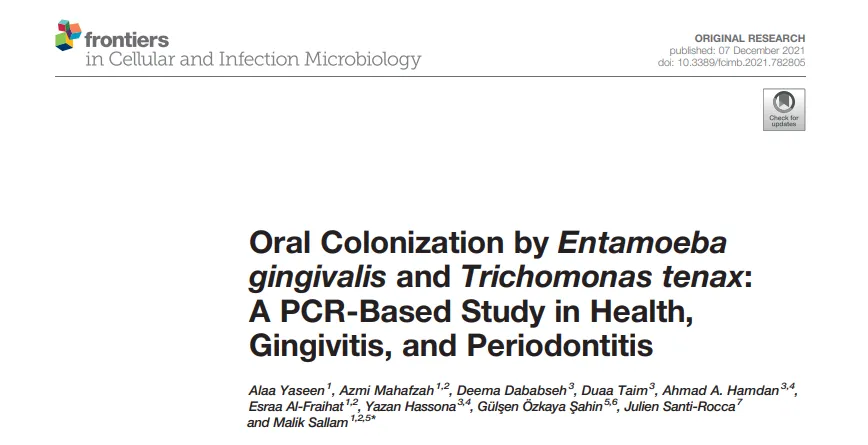Blog

Oral Colonization By Entamoeba Gingivalis And Trichomonas Tenax. A PCR-Based Study In Health, Gingivitis, and Periodontitis
Oral Colonization by Entamoeba gingivalis and Trichomonas tenax: A PCR-Based Study in Health, Gingivitis, and Periodontitis
Alaa Yaseen1 , Azmi Mahafzah1,2, Deema Dababseh3 , Duaa Taim3 , Ahmad A. Hamdan3,4, Esraa Al-Fraihat1,2, Yazan Hassona3,4, Güls¸en Özkaya S¸ ahin5,6, Julien Santi-Rocca7 and Malik Sallam1,2,5*
1 Department of Pathology, Microbiology and Forensic Medicine, School of Medicine, The University of Jordan, Amman, Jordan, 2 Department of Clinical Laboratories and Forensic Medicine, Jordan University Hospital, Amman, Jordan, 3 School of Dentistry, The University of Jordan, Amman, Jordan, 4 Department of Oral and Maxillofacial Surgery, Oral Medicine and Periodontology, Jordan University Hospital, Amman, Jordan, 5 Department of Translational Medicine, Faculty of Medicine, Lund University, Malmö, Sweden, 6 Department of Clinical Microbiology, Laboratory Medicine, Skåne University Hospital, Lund, Sweden, 7 Science and Healthcare for Oral Welfare, Toulouse, France
Background: The etiology of periodontitis remains unclear, as is the place of gingivitis in its pathophysiology. A few studies linked the colonization by oral parasites (Entamoeba gingivalis and Trichomonas tenax) to periodontal disease and its severity. The aim of the current study was to estimate the prevalence of these oral parasites among healthy individuals, and in patients with gingivitis and periodontitis in Jordan.
Methods: The study was conducted during July 2019–December 2019. Samples were composed of saliva and periodontal material including dental plaque sampled with probes. The detection of oral parasites was done using conventional polymerase chain reaction (PCR).
Results: The total number of study participants was 237: healthy (n=94), gingivitis (n=53) and periodontitis (n=90). The prevalence of E. gingivalis was 88.9% among the periodontitis patients, 84.9% among the gingivitis patients and 47.9% in the healthy group. For T. tenax, the prevalence was 25.6% among the periodontitis patients, 5.7% among the gingivitis patients and 3.2% in the heathy group. Positivity for E. gingivalis was significantly correlated with the presence of periodontal disease compared to the healthy group with odds ratio (OR) of 6.6. Periodontal disease was also correlated with lower monthly income (OR=8.2), lack of dental care (OR=4.8), and history of diabetes mellitus (OR=4.5). Colonization by E. gingivalis was correlated with gingivitis (OR=6.1) compared to the healthy group. Colonization by E. gingivalis and T. tenax were significantly correlated with periodontitis (OR=6.4 for E. gingivalis, and OR=4.7, for T. tenax) compared to the healthy group. T. tenax was only detected among individuals with generalized periodontal disease compared to its total absence among those with localized disease (19.6% vs. 0.0%; p=0.039). The co-infection rate by the two oral parasites was 11.0%.
Contact Us
+61 404 039 649
